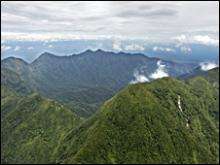September 8, 2009 weblog
Lost World Found in Papua New Guinea Volcano

(PhysOrg.com) -- A BBC expedition exploring inside the crater of an extinct volcano in Papua New Guinea (PNG) has discovered a lost world of dozens of weird new species and rare animals, including new frogs, a giant rat, many new insects and spiders, giant caterpillars, and a new bat species.
Steve Greenwood, producer of "Lost Land of the Volcano" said the expedition to Mount Bosavi for the series follows on from expeditions to remote rainforests in Borneo for "Expedition Borneo" and Guyana for "Lost Land of the Jaguar".
The Mount Bosavi crater is 2.5 miles wide and over 3,300 feet high, and is located in the remote and mountainous southern highlands of Papua New Guinea. The mountain and its pristine, extinct crater are so inaccessible that even the few people in the Kasua tribe who live in nearby villages rarely enter the area.
One of the village elders told Greenwood, "if you fall when climbing in, no one will ever find your body."
The expedition, from 30 January to 4 March 2009, included two directors, two cameramen, two sound recordists, support staff, a medical expert, expert tree climbers and cavers, trackers from the Kasua tribe, and several scientists, led by Professor George McGavin, an Oxford University Research Lecturer and Assistant Curator of Entomology in the Oxford University Museum of Natural History.
The number of new species found cannot be confirmed until the biologists have finished evaluating the finds, but they believe there may be up to 40 previously undescribed species. This includes 20 new species of insects and spiders, 16 species of frogs, a new bat, and at least three fish species. Many of the new species discovered are believed to exist only in the Mount Bosavi crater.
Some of the weird animals they discovered included a fish that uses its swim bladder to make grunting sounds, a frog with fangs, a camouflaged gecko, fantastic spiders, a rat almost three feet long, and the rare Doria's tree kangaroo. The animals had no fear of the expedition team, suggesting they had not encountered people before because the huge crater's inaccessibility had effectively excluded them.
One of the expedition scientists, Dr Kristofer Helgen from the Smithsonian National Museum of Natural History, said the giant rat they found was one of the largest in the world. It was first spotted at an elevation of over 3,300 ft by an infrared camera trap set up in the forest by cameraman Gordon Buchanan, and this was followed by finding a live specimen. The captured rat measured 32 inches from the tip of the tail to the nose, and weighed about 3.3 pounds. The scientists have tentatively named the animal the Bosavi woolly rat, and think it belongs to the genus Mallomys, which includes several other giant rats.
The television series on this amazing crater and its lost world of strange animals is called "The Lost Land of the Volcano" and premieres on Britain's BBC1 on 8 September 2009.
• Join PhysOrg.com on Facebook!
• Follow PhysOrg.com on Twitter!
via BBC
© 2009 PhysOrg.com

















